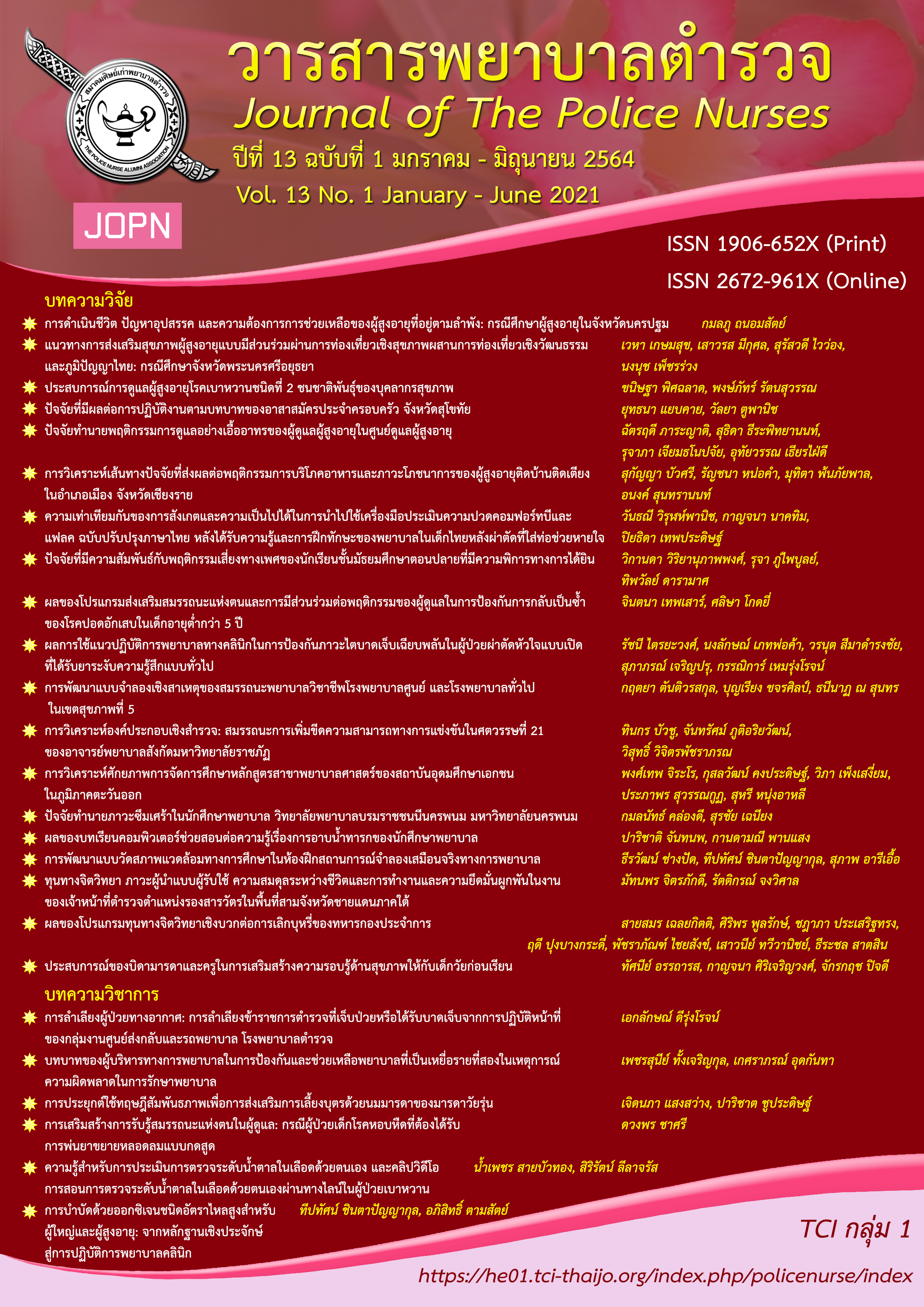LIFE STYLE, PROBLEMS AND NEEDS AMONG ELDERS LIVING ALONE: A CASE STUDY OF OLDER ADULTS IN NAKHON PATHOM PROVINCE
Keywords:
lifestyle, elders, living aloneAbstract
This qualitative research was intended to investigate the lifestyle, problems, and needs of elders living alone. This study's key informants are comprised of 25 elders living alone in Nakhon Pathom Province. The research instrument consisted of 13 items of semi-structured in-depth interview form. Data were analyzed using content analysis. Additionally, data triangulation, method triangulation, and review triangulation were performed to verify the data's trustworthiness.
The findings illustrated that problems of elders living alone consisted of 1) food chewing, 2) consuming a high fat, high sugar, and high salted diet, 3) inability to supply healthy food for themselves, 4) inadequate physical activities, 5) poor sleep quality, 6) consuming tobacco and alcohol, 7) abnormal digestion and excretion, 8) having an underlying disease, 9) having low self-esteem, 10) having depression, 11) poor supporting for crucial information, 12) inability to participate or engage themselves in any social activities, 13) inadequate social welfare; and 14) prone to home accidents. Moreover, their needs consisted of accessibility to quality and sufficient food, personal health care and environment, health care behaviors, transportation service to the doctorand sufficient income. The participants received some social allowance such as elderly allowance or handicap allowance. Furthermore, some special supports were provided for them, such as essential health investigation, recreational activities, and religious and traditional activities.
This study's results could be used as empirical evidence-based for policymakers to establish service provisions to encourage older people living alone to perform their daily 12activities and guarantee access to health care for them.
Downloads
References
American Diabetes Association. (2019). 6. Glycemic targets: standards of medical care in diabetes-2019. Diabetes care, 42(Suppl 1), S61-S70.
Boukeaw, P., & Teungfung, R. (2018). Health care and health status of Thai aging. Journal of the Association of Researchers, 21(2), 94-109.
Chesnay, M. D. (2017). Nursing research using case studies: Qualitative designs and methods in nursing. New York, NY: Springer Publishing Company.
Coll, P. P. (2019). Healthy aging: A complete guide to clinical management. Switzerland: Springer International Publishing.
Foundation of Thai Gerontology Research and Development Institute. (2016). Situation of the Thai elderly 2016. Nakhon Pathom: Printery.
Institute for Population and Social research Mahidol University. (2014). Population and society in ASEAN: Challenges and opportunities. Bangkok: Octoberprint.
Huang, J., Zou, Y., Huang, W., Zhou, Y., Lin, S., Chen, J., & Lan, Y. (2020). Factors associated with physical activity in elderly nursing home residents: A path analysis. BMC Geriatrics, 20(1), 274. https://doi.org/10.1186/s12877-020-01676-8
Kennedy-Malone, L., Plank, L. M., & Duffy, E. G. (2019). Advanced practice nursing in the care of older adults (2nd ed.). Philadelphia, PA: F.A. Davis.
Khan, H. T. A. (2019). Population ageing in a globalized world: Risks and dilemmas? Journal of Evaluation in Clinical Practice, 25(5), 754-760.
Ministry of Social Development and Human Security. (2014). Thai elderly population: Present and future. Bangkok: Ministry of Social Development and Human Security.
Murphy, J. L., Holmes, J., & Brooks, C. (2017). Nutrition and dementia care: Developing an evidence-based model for nutritional care in nursing homes. BMC Geriatrics, 17, 1-14.
Nielsen, D. L. (2018). Elderly care: Options, challenges and trends. New York, NY: Nova Science Publishers, Inc.
Panyathorn, K., &Trongsri, C. (2020). Healthcare and related factors of the elderly living alone in Bantad, Mueang district, Udonthani province. APHEIT Journal of Nursing and Health, 2(2), 41-52.
Preyer, G., & Amoretti, M. C. (2011). Triangulation: From an epistemological point of view. Berlin: De Gruyter.
Samutchak, P. (2017). Caring for vulnerable family in the social and demographic transition. Nakhon Pathom: Mahidol University.
Siritarungsri, B., Soranastapom, S., Malee, S., Francis, K., & Mills, J. (2015). Strategies for successful ageing living alone. Journalism and Mass Communication, 5(2), 87-97.
Sudsomboon, S. (2014). Social welfare for aging people in Thailand. Journal of Southern Technology, 7(1), 73-82.
The National Statistical Office. (2018). Report on the 2017 survey of the older persons in Thailand. Bangkok: Text and Journal Publication.
Unger, T., Borghi, C., Charchar, F., Khan, N. A., Poulter, N. R., Prabhakaran, D., . . . Tomaszewski, M. (2020). 2020 International society of hypertension global hypertension practice guidelines. Hypertension, 75(6), 1334-1357.
Zhu, X., Hu, Z., Nie, Y., Zhu, T., ChiwandaKaminga, A., Yu, Y., . . . Doering, S. (2020). The prevalence of poor sleep quality and associated risk factors among Chinese elderly adults in nursing homes: A cross-sectional study. PLoS ONE, 5. https://doi:10.1371/journal.pone.0232834
Downloads
Published
How to Cite
Issue
Section
License
ผลงานที่ได้ตีพิมพ์แล้วจะเป็นลิขสิทธิ์ของวารสารพยาบาลตำรวจ















